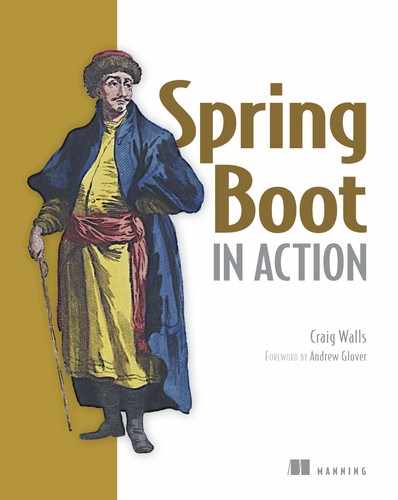Table of Contents
Chapter 1. Bootstarting Spring
1.1.1. Taking a fresh look at Spring
1.2. Getting started with Spring Boot
1.2.1. Installing the Spring Boot CLI
1.2.2. Initializing a Spring Boot project with Spring Initializr
Chapter 2. Developing your first Spring Boot application
2.1. Putting Spring Boot to work
2.2. Using starter dependencies
2.3. Using automatic configuration
2.3.1. Focusing on application functionality
Chapter 3. Customizing configuration
3.1. Overriding Spring Boot auto-configuration
3.1.1. Securing the application
3.1.2. Creating a custom security configuration
3.1.3. Taking another peek under the covers of auto-configuration
3.2. Externalizing configuration with properties
3.2.1. Fine-tuning auto-configuration
Chapter 4. Testing with Spring Boot
4.1. Integration testing auto-configuration
4.3. Testing a running application
Chapter 5. Getting Groovy with the Spring Boot CLI
5.1. Developing a Spring Boot CLI application
5.1.1. Setting up the CLI project
5.3. Running tests with the CLI
Chapter 6. Applying Grails in Spring Boot
6.1. Using GORM for data persistence
6.2. Defining views with Groovy Server Pages
6.3. Mixing Spring Boot with Grails 3
6.3.1. Creating a new Grails project
Chapter 7. Taking a peek inside with the Actuator
7.1. Exploring the Actuator’s endpoints
7.1.1. Viewing configuration details
7.1.2. Tapping runtime metrics
7.2. Connecting to the Actuator remote shell
7.2.1. Viewing the autoconfig report
7.2.2. Listing application beans
7.3. Monitoring your application with JMX
7.4.2. Enabling and disabling endpoints
7.4.3. Adding custom metrics and gauges
Chapter 8. Deploying Spring Boot applications
8.1. Weighing deployment options
8.2. Deploying to an application server
Appendix A. Spring Boot Developer Tools
Appendix B. Spring Boot starters
